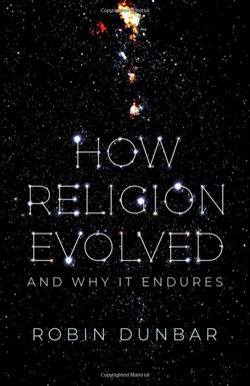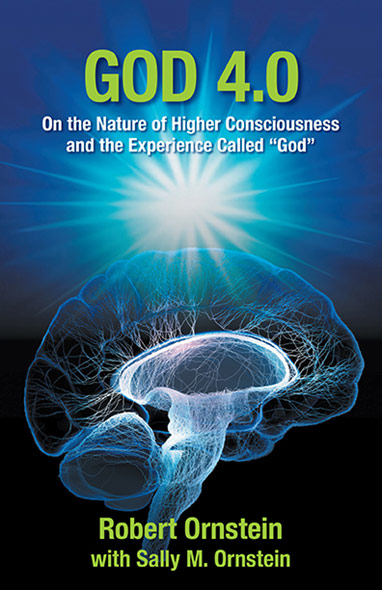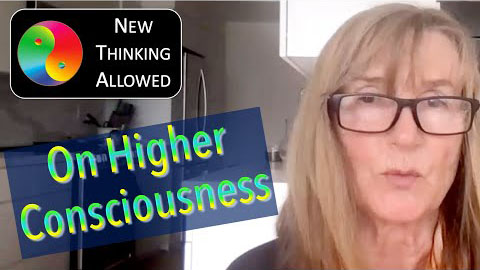Featured Books
A Contemporary Look at the Nature of Religious Experience
By George Kasabov
An exploration of two recent books on the subject: How Religion Evolved: And Why It Endures, by Robin Dunbar, and GOD 4.0: On the Nature of Higher Consciousness and the Experience Called “God, by Robert Ornstein with Sally M. Ornstein.
People can persuade themselves of anything. Many believe that death is a transition to a transcendental world, that miracles occur through the will of God, or that our lives are ruled by immaterial spirits. How is it that, in our scientific age, when we have learned so much about the evolution of the universe and the nature of life, so many still cling to such beliefs? Why is it that faith – belief in the unprovable – is considered a virtue?
Two recent books bring these strange phenomena into focus by viewing the nature of religious experience through the lens of modern knowledge about society and the human brain.
In his 2022 book, How Religion Evolved: And Why It Endures, Robin Dunbar examines the built-in psychological tendencies in us human animals which lead to such beliefs. In God 4.0: On the Nature of Higher Consciousness and the Experience Called “God”, published in 2021, Robert Ornstein and Sally Ornstein cover some of the same data but reach different conclusions.
The Brain and Religious Belief
Both Dunbar and the Ornsteins assert that religious behaviour results from the way the human brain has been formed to operate by its adaptation to the exigencies of evolution. Brain structures, which have evolved to facilitate life in large groups, have also produced a tendency to interpret the world in a way that leads to religious belief, to belief in the power of unseen beings.
Dunbar claims that the spiritual forces which religious people claim to recognise are not necessarily real, but that they have come to be accepted as real in response to social demands. Our brains have evolved in response to new conditions. Imagining a spiritual world, invisible to the senses, has aided this process. So, he claims, religion is an epiphenomenon, a secondary result of human brain development, a response to the environmental challenges of the past 200,000 years.
The Ornsteins take a similar view about the evolution of the brain but point out that there is no smoke without fire; that many religious impulses are due to actual insights, however primitive their formulation may once have been, or however much their interpretation may have deteriorated over time.
Recent Developments in Neurology
In the past sixty years the functions of different parts of the brain have been illuminated as never before. Dunbar and the Ornsteins have used this new knowledge to describe the processes whereby different mental states are experienced, and to identify the kind of personality who is likely to interpret these experiences in terms of religion.
For instance, they point out that the human brain has a hyperdeveloped set of interconnected regions known as the Default Mode Network (DMN). Discovered only in 2001, this consists of the prefrontal cortex, the temporal cortex, the temporo-parietal junction and the limbic system.
This network is most developed in primates, but particularly so in homo sapiens. It is these regions which are responsible for making sense of others’ beliefs and mental states, and for managing our relationships in large societies.
Some describe the DMN as the brain’s “orchestra conductor” or “corporate executive” —a physical component of the self, the neural seat of our personal identity. However, the DMN is a double-edged sword. For it both facilitates certain functions and blocks others. While it helps togetherness and interaction, it blocks insight (thinking outside the box).
The Ornsteins write of the DMN: “we might expect its temporary disappearance from the stage to lead to the concert coming apart and, thus, to an increase in dissonance and mental incoherence. This does, in fact, appear to happen during psychedelic “trips” and in other extraordinary experiences brought about by different means… when the DMN shuts down, other brain regions “are let off the leash.” You experience a dissolution of the self, opening up a more comprehensive viewpoint, a viewpoint from which a wider set of connections can take place.
Human Irrationality
Most people in our modern Western culture imagine that people behave rationally. But we have to accept that we are profoundly irrational, that irrationality is the normal human mode of behaviour. We are driven by subconscious reactions which may have been appropriate in simpler times but are often not so now. So, when we judge our actions, we need to recognise that they may stem from impulses of which we are unaware, and which may not be appropriate.
We tend to believe something is true because our reference group, our friends, believe it to be true. We believe in religion because we humans have an inherent need to understand how the world works and, before the rise of science, it was the only way to access the hidden world beyond our senses. Despite our ignorance, we tried to make sense of our place in the universe as best we could.
Lacking sufficient understanding, we invented unknowable causes, or Gods to assuage our longing for certainty. Such ignorance still spawns new religions today, all over the world.
Dunbar points out that there is an ever-changing array of at least seven thousand different religions at any one time. All these religions exist together, and not only do they coexist, but they split up, they die, and they proliferate as new ones are born.
As well as the offshoots of the main monotheisms, there are many others, like the Cargo cults of Melanesia, the Moonies of Korea, and the snake handing cults of Appalachia. Because the theology of such religions is based on assertion, not knowledge, constant dissidence and change is inevitable.
The Progression of Religious Ideas
As human population grew, and groups became larger, there was more need to diffuse social tension and violence. Dunbar claims that “organized religions seem to have been part of the machinery used to keep the lid on fractiousness so as to allow larger communities to exist.” As well as this, there grew a need to give expression to the burgeoning capacities of the human mind and to understand the nature of the universe.
There is a historical progression – stages of religious ideas and practices that developed one after another, but now all exist together.
The first is probably Animism, in which everything is seen as alive, not just animals and plants, but the earth, its rocks, soils and rivers, the sun, the rain, thunder and lightning. Belief in such beings arose in the mists of time and still persists. It has been much revived in the West since the 1960s.
Shamanism, the conjuring of spirits and mysterious forces, is also ancient and is still practiced in many parts of the world. Shamans claim to be in touch with the invisible spirit world, which they do by attaining an altered state of consciousness. They reach this by disciplined mental and physical exercise and often by the use of psychoactive substances such as mescaline, peyote, and psilocybin. Such drugs change the way that the brain interprets environmental impacts. This is often disorientating, and such experiences, due to organic malfunction, are often mis-interpreted as a deeper reality, they show the malleability of the mind.
Next came Polytheism, the worship of many Gods, which arose about 5,000 years ago, when larger and more settled societies appeared. Dunbar notes: “there is a natural progression from informal religions in small-scale societies to formal religions in large-scale societies as a way of managing the stresses involved.”
Polytheism appeared together with agriculture and pastoralism. It arose in societies which had to cope with an increase of population density and social pressure. The solution was to adopt social stratification and hierarchy – specialisation of social roles – with kings, soldiers, priests, accountants, farmers and craftsmen all obliged to a pantheon of gods (or so the kings said).
Beginning in the Fertile Crescent, Polytheism emerged all over the world, from the Mediterranean to the Americas and the East. Each of the many deities that were invented represented a particular aspect of life and the world. Among them were Marduk, the creator god of the Babylonians, Aphrodite, the goddess of love of the Greeks, Ra, the Egyptian god of the sun, or Mars, the Roman god of war. We still see this in the many Hindu gods, the Shinto spirits, and in the multitude of Christian saints.
And then, about 3,000 years ago, came the Monotheisms, the worship of one God; first with Judaism and Zoroastrianism, then Christianity, and finally about 1,400 years ago, with Islam. As with previous forms of religion, the Monotheisms are subject to misrepresentation, to decay, to constant fragmentation and conflict. They have continually spawned new variants, new cults and sects, each claiming to be the depository of ultimate truth.
Then there are the religions without a god, which appeared around 2,500 years ago, such as Buddhism, Confucianism and Taoism. They focus on the attainment of human meaning through disciplined action and attitude. Some of this impulse still remains. But, like other religions, their original impact has mostly been lost over time. They have degenerated, fragmented and proliferated, taking on the magical thinking that is characteristic of primitive humanity.
The Evolution of Ideas
Darwin’s theory of natural selection describes a process of adaptation, not progress. But cultural evolution can progress from naïve ideas about the nature of reality to more sophisticated ones.
The Ornsteins point out that, even when “modern” religions developed, people didn’t know about such things as weather systems or cosmology, or the geologic age of the Earth. They didn’t know that the brain is involved in thought and the control of the body, or that genes influence our development. People were profoundly ignorant about all scientific matters. What happened in the world was a great mystery. So, it is easy to understand why those mysteries could be named as Gods.
Much of this is now understood, and since the mid 19th century, we have got used to thinking of the physical and behavioural evolution of animals. We also accept that ideas evolve. However, we tend to restrict the evolution of ideas to ideas about science and technology.
Ideas about religions mostly don’t evolve on the basis of practical experience, they tend to remain in the domain of faith, of assertion, though the assertions of different religions are very different from each other. Belief in religion is more the result of indoctrination, than of perception and understanding.
Old and uninformed ideas about religion are not superseded by new and more accurate ones about its actual function; about how ideas propagate and influence behaviour. Instead, believers accept religious ideas as dogma, and unbelievers reject them as fantasy. What is needed is an update, an update to show what is relevant.
The Supercession of Ideas
The Ornsteins state that religions, like everything else in this domain of decay, are “subject to the unavoidable cycle of innovation in all of our all-too-human institutions — inspiration, creation, growth, extension and then decay… Enlightened individuals seek to initiate a new approach or radically reform an existing one. Then in a consolidation stage, a hierarchy is built up. And finally comes a sclerotic stage, in which the bureaucracy works for itself, and practices are hidebound … Ripe for a revolution, the cycle then begins anew.”
But are we destined to repeat such cycles endlessly? I suspect we mostly are. Nevertheless, the occasion when a new outlook on the world occurs to anyone is to be celebrated.
For instance, the famous physicist, Carlo Rovelli, states that he became a physicist because an LSD trip radically changed his mode of perception. He thought “Well, it’s a chemical that is changing things in my brain. But how do I know that the usual perception is right, and this is wrong? If these two ways of perceiving are so different, what does it mean that one is the correct one?”
It certainly did not give him answers, but it did trigger new questions about the nature of reality. He explains that now: “We have discovered that at the heart of physical reality, it’s not particles, it’s relational connections. Each object is defined by the way it interacts with something else. So, when it’s not interacting, it’s just not existing.”
This is a sophisticated take on a conceptual conundrum that tests our view of reality. And if you ask any physicist whether the nature of matter and the universe is fully understood, the answer will be a resounding no. The same applies to psychology, even though it has advanced tremendously in the past sixty years.
Belief or Perception
While Dunbar limits religion to the realm of belief and social practice, the Ornsteins extend it to the realm of perception: the difference between believing what you are told and actually experiencing it – seeing it for yourself – which requires that a person’s perceptual faculties are capable of actual experience and are not deceived by fantasy.
The Ornsteins assert that we are “endowed with a quiescent second network of cognition which, when activated, can dissolve or break through the barriers of ordinary consciousness.” They point out that the “right parietal lobe (RPL) is associated with defining or perceiving the self, including distinguishing it from not-self. Disabling it can lead to a connection with things “beyond the self,” which is often experienced as a mystical state.”
Right parietal lobe malfunctions can lead to Schizophrenia, to being over-imaginative (or to Autism, being under-imaginative). But it is not necessarily evidence of mental delusion to claim that you have perceived something which is not generally recognised as real. It can be evidence of a higher state of consciousness. It can result from the extension of human capacity for perception; perception outside the five senses. For these senses have only evolved to support ordinary animal existence.
Our hunches are often real perceptions and need to be recognised as such. We connect to a larger whole beyond the self. It is important to realize that “when any of us face a problem and suddenly have a “breakthrough” insight – when we go from being stuck to suddenly “seeing” the solution – we are partially activating the same second network of cognition accessed by the great prophets and spiritual teachers in forming their transformative insights… Archimedes shouted “Eureka!” (I have found it!) when he suddenly discovered that water displacement could be used to calculate density.”
Neurological studies confirm that such insights occur after the brain’s left hemisphere has got stuck in the details of a problem and gives up, at which point the right hemisphere takes over, seeing the problems as a whole, and leading to insight. They use the term “brain blink” to describe this moment when your brain turns off the competing activity, just before the “aha!” moment. Something that every creative individual has experienced.
The Limits of Normal Perception
Our perceptual organs, our ears, skin, eyes, etc. have all evolved to accept only a very restricted range of stimuli, those stimuli that are useful for survival in our primitive environment. Our senses are just as specific and limited as those of other kinds of animal. They are as specific as the magnetic sense of the homing Pigeon, the ultra-violet light receptors of the Bee, or the capacity of the Bat to perceive hypersonic vibrations.
Yet we are constantly bombarded with a vast array of stimuli which lie outside our range. As animals, we remain necessarily unaware of them. Because they do not contribute to our physical wellbeing, we have not needed to evolve senses that can perceive them. Thus, they remain outside our ken.
Nevertheless, these stimuli are part of the whole universe, the universe which we don’t experience as it is, but as a “virtual reality” — a small, limited system which only evolved to keep us safe and ensure our survival.
The Ornsteins describe it as: “a personal construction… computed within our minds, not a full or accurate registration of what is outside… The “reality” each organism lives inside… is a virtual one… a virtual “Imaginarium” that’s rich with the stories provided by our culture and the stories we tell ourselves.”
As Aldous Huxley noted, “To make biological survival possible, Mind at Large has to be funnelled through the reducing valve of the brain and nervous system. What comes out at the other end is a measly trickle of the kind of consciousness which will help us to stay alive on the surface of this particular planet.”
However, in the past four hundred years we have been made aware of many of these un-sensed stimuli. They have become available to us by means of technology. Technology which extends the range of our faculties. We perceive them with the aid of instruments such as the Telescope, which reveals the distant, the X ray Scanner, which reveals the hidden, or the Particle Accelerator, which reveals the infinitesimal.
The Ornsteins point out that there are also other ways of being which we can only reach by attuning and extending our minds. That the recognition of, and perception of the significance of these (mostly unperceived) conditions is what religiously talented people have called God. They give access to a fuller understanding of life.
They state that the “knowledge we have now of how higher consciousness happens in the brain, allows us to move beyond faith, belief, and ritual to a direct experience of self-transcendence which has been called “seeing God.”
We need to look past the devout multitudes who undoubtedly gain real satisfaction from their experience of congregation in environments that are designed to inspire overwhelming emotions, like exhilaration, awe, and reverence; environments such as a Church service or a Rock concert. Instead, we need to look for what is actually going on somatically, psychologically and culturally when people live through experiences of this kind.
Refocus Attention
So, how can we reach such insight? How can we adjust our minds to access this realm of understanding? It is all a matter of our mental stance, as what we can perceive is determined by our attitude, our habitual way of thinking and of acting. It is essential to cultivate those modes of being, those mental states that can reveal a fuller reality.
The Ornsteins quote the neuroanatomist Jill Bolte Taylor who, in ‘My Stroke of Insight’, describes her experience of a massive haemorrhage in the left hemisphere of her brain. This meant that her brain’s left hemisphere no longer inhibited, or competed with, the right hemisphere. She felt “swathed in an enfolding sense of liberation and transformation. … I’m no authority, but I think the Buddhists would say I entered the mode of existence they call Nirvana.”
She gave herself up to entrancing feelings of “tranquillity, safety, blessedness, euphoria and omniscience.” Later, she recalled, “In the absence of … normal functioning … my perception of my physical boundaries was no longer limited to where my skin met air. I felt like a genie liberated from its bottle.”
Taylor no longer knew anything about the neuroanatomist she had been until that moment and no longer felt bound to her “self-induced limitations.” She also did not have her old passions or anger or the emotional baggage that she had been carting through her life — instead she simply “was.”
“It took eight long, hard years of relearning everything before Taylor finally recovered the functioning of her brain’s left hemisphere”. But “she didn’t want to return to the old world of “separateness” in which greed, power games, egotism… took precedence… the complete knockout of the brain’s left hemisphere led to the dramatic breaking of the barriers of the left hemisphere’s control over the right hemisphere’s perceptual abilities — abilities that, like the stars existing behind the brilliance of the day, are often obscured.”
Now, we don’t need to be disabled by a stroke to achieve insight. Instead, we can tune our minds so that we can become more aware, to be less constrained by our habitual interpretation of events, to live more fully.
The injunction to act virtuously, found in all religious traditions, moves our consciousness away from its ordinary, self-centered mode to a wider vision. This is why spiritual experiences are described as “selfless,” “timeless,” “placeless,” “thing-less,” and “higher”. As they are nonverbal, they are very difficult to talk about — and, if talked about, they sound flaky. Nevertheless, they are essential.
The Ornsteins quote Nelson Mandela, writing from his cell in South Africa’s Robben Island. “In judging our progress as individuals, we tend to concentrate on external factors such as one’s social position, influence and popularity, wealth and standard of education… But internal factors may be even more crucial in assessing one’s development as a human being. Honesty, sincerity, simplicity, humility, pure generosity, absence of vanity, readiness to serve others — qualities which are within easy reach of every soul — are the foundation of one’s spiritual life.”
Epiphenomena or Actual Insights
Though these two books cover much of the same ground, they reach different conclusions about the range and capacity of human consciousness. Dunbar provides an anthropological context, treating religion purely as an epiphenomenon. The Ornsteins refer to modern psychology and Sufi teaching stories to explore the further reaches of the human mind.
Both identify a progression of religious practice, starting from Animism and Shamanism (what the Ornsteins call God 1.0), going on to Polytheism (God 2.0) and then to Monotheism (God 3.0). In God 4.0, the Ornsteins focus on personal knowledge within our interconnected universe. In stages 1, 2 and 3, the concept of God is used with historical legitimacy. But stage 4 no longer needs the traditional idea of a God like the biblical Jehovah.
Dunbar states that religion “confers an advantage: it can benefit our individual health and wellbeing, but, more importantly, it fosters social bonding at large scale, helping hold fractious societies together”.
Also, “Like the growth of knowledge over time, the phases of religion are simply a case of humans finding solutions to the social and environmental threats that have bedevilled them at different stages in history. They represent successive solutions to the stresses that arise as population size increased.”
He concludes: “it is difficult to see any convincing evidence for anything that will replace religion in human affairs. Religion is a deeply human trait. The content of religion will surely change over the longer term, but, for better or for worse, it is likely to remain with us”.
The Ornsteins concur, but they go further. They assert that, even though many of us don’t recognise the extent of our capabilities, our development as humans allows us to achieve a more comprehensive understanding of the universe. Sunk as we are in selfish pursuits, we usually remain unaware of this potential.
They quote the Sufi teacher, Jalaluddin Rumi, who said: “Originally you were clay. From being mineral, you became vegetable. From vegetable, you became animal, and from animal, man. During these periods man did not know where he was going, but he was being taken on a long journey, nonetheless. And you have to go through a hundred different worlds yet. There are a thousand forms of mind”.
They point out that humans have the potential to develop further. This development is not in the physical realm, but in the realm of perception. Humans can learn to see things more as a whole and altogether, as if from above – the way of seeing mediated by the right half of the brain. What we need is not faith, but a deeper understanding of reality through personal knowledge. For he who tastes, knows.
About the Book’s Authors:
Robin Dunbar began his career at Oxford, working under the ethologist Niko Tinbergen, studying Gelada baboons. He then went on to study the behaviour of that related simian species, homo sapiens (us), also from an ethological standpoint. This approach has turned out to be very fruitful, explaining many aspects of human behaviour which had remained mysterious until now. He is head of the Social and Evolutionary Neuroscience Research Group at Oxford University.
Robert Ornstein is a psychologist who founded the Institute for the Study of Human Knowledge. He first worked with patients who had undergone an operation to sever the corpus callosum, the junction that connects the two halves of the brain. This revealed that each half of the brain functions in a different manner from the other half and led to a new understanding of inner experience, formerly the exclusive domain of religion. He examined the consequences in The Psychology of Consciousness, published in 1972, a time when the hard question of consciousness was still almost a taboo subject in science.
This article is to appear in Italian, in the journal Aspenia, www.aspeninstitute.it
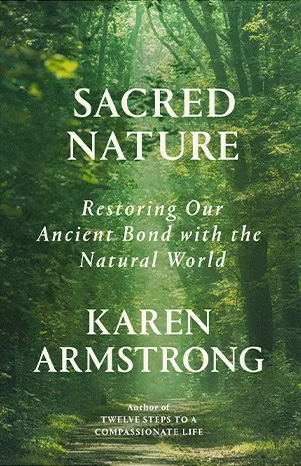
Returning to the Spirit in “Sacred Nature”
A review of Sacred Nature by Karen Armstrong
A staggering 33 million people have been internally displaced in Pakistan. Because climate change is likely to have played a role in the heavy rains, the displaced can be considered “climate refugees”— a term that the novelist Fatima Bhutto urges us remember, as we will all be impacted by climate change, and many of us will become migrants as a result, if we haven’t already.
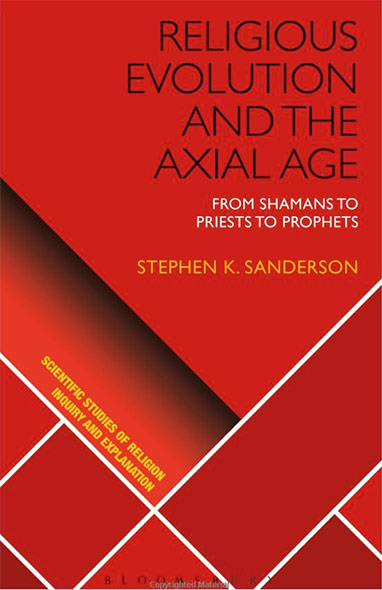
Religious Evolution and the Axial Age
From Shamans to Priests to Prophets
Hardcover edition 2018
Reported by Sally Mallam
Contributing Writer
Why are there are so many different types of religion and how and why has religion evolved over time? The answer lies in both our biological and our sociocultural evolution.

